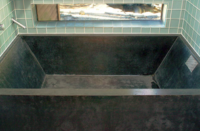Fabien Mené, a French native and art collector, never thought he’d find himself working in decorative concrete. It all started after studying art at the Charles de Gaulle University, Lille III. The idea of creating stenciled tables came to him after making bar counters in a class and wondering if he could add a stencil to the bottom of a casing.
“I did some research and saw this technique was scarcely used,” says Mené. “So I decided to keep on that track to make more and more elaborate patterns and effects.”
After graduating, he moved to Brussels, Belgium, a vibrant city filled with street art, where he spent three years gaining inspiration from art exhibitions. From Brussels he traveled to Australia, where Mené met his now-wife, Genevieve. They relocated to northern Canada in an area inhabited with Inuits, a Native American people also called Eskimos.
 Isolated from much of the world, Mené devoted his ample free time to develop and improve his stencil-based style that begins with drawing a pattern on leather, cutting it with a scalpel and placing it at the bottom of his concrete framework before the pour. The stencils are reusable, usually up to five times, and are also customizable. Sometimes he’ll use a rotary tool to carve directly into the concrete to add small details.
Isolated from much of the world, Mené devoted his ample free time to develop and improve his stencil-based style that begins with drawing a pattern on leather, cutting it with a scalpel and placing it at the bottom of his concrete framework before the pour. The stencils are reusable, usually up to five times, and are also customizable. Sometimes he’ll use a rotary tool to carve directly into the concrete to add small details.
“After my daughter was born, we decided to move back to Quebec City where I took a class on concrete to understand the basics,” says Mené. He also got a job with a company that polishes concrete floors and learned a lot about the techniques and chemicals used in the process.
Since this introduction, he began making concrete counters and tables and has been doing so for about a year.
 Mené uses regular concrete to build his tables, as he likes the idea of transforming a simple raw material into an elaborate finished product. The actual table-making process isn’t time-consuming, he says, but finding the right pattern and color and pairing them with an appropriate base that aptly suits the stencil definitely is. Typical tables weigh between 30 and 60 pounds.
Mené uses regular concrete to build his tables, as he likes the idea of transforming a simple raw material into an elaborate finished product. The actual table-making process isn’t time-consuming, he says, but finding the right pattern and color and pairing them with an appropriate base that aptly suits the stencil definitely is. Typical tables weigh between 30 and 60 pounds.
“The table takes longer to complete in my head than it actually does when it comes down to it,” says Mené. Polishing adds a few hours to the process.
To date, the most unusual table he’s made is a wooden-effect table where he mixed up the recipe and the surface cracked. This “accident” led Mené to set it aside since he still felt it was a beautiful piece. He later accidentally spilled acid on it and his results were astounding. “I found myself with a wonderful table and I now try to obtain the same effect on purpose!” says Mené.
He recently opened Kind Of Béton, a small business that promotes his tables on Facebook. Mené plans to adapt his stencil and acid polishing techniques and open an innovative flooring shop in the near future.

















